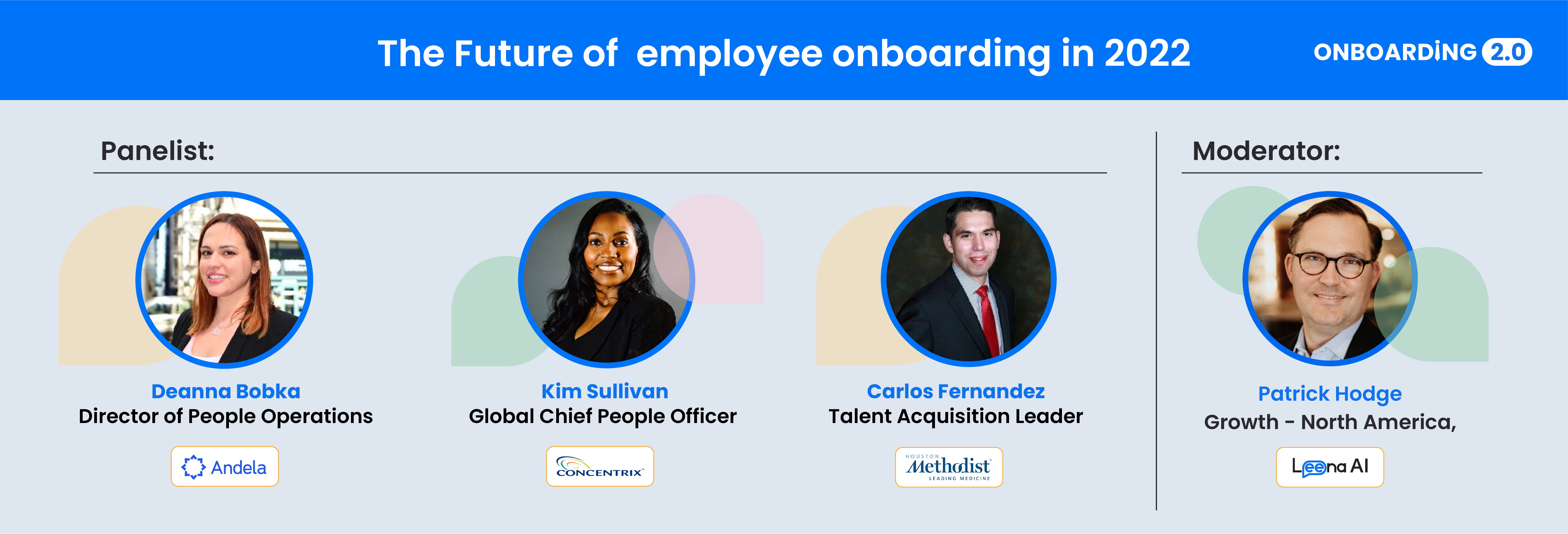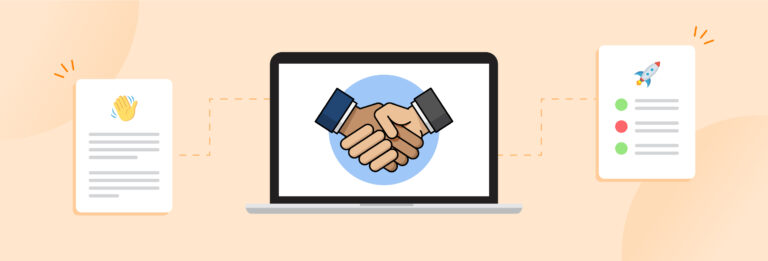A revamped spotlight on the onboarding process has shown that a wide chasm is present between the hiring and assimilation process. Our studies show that 40% of senior managers and HR leaders have felt the disconnect in their operations. As a result, new team members can take up to a year to feel comfortable in their role. Moreover, there are reports of a rise in feelings of abandonment and a lack of personalized mentoring.
This situation is a ticking explosive for HRs and talent acquisition leaders. If left unchecked, the organization is primed to face the brunt of a talent drain and huge losses in revenue.
Leena AI’s Patrick Hodge recently spoke to three experts in the HR domain regarding the situation. They deep-dived into the reason for present gaps in the hiring process and how to address them effectively. Here are the key takeaways.

AI in HR automation needs to be the key driver for scaling up talent acquisition processes. Otherwise, businesses will likely get stuck in a limbo of manual tasks and human errors.
Global companies that have a big workforce need to focus on onboarding using AI automation, especially if the plan is to carry out aggressive hiring. And with most teams adopting a hybrid set-up, where members log in from different time zones, automating the onboarding process can provide easy access to critical information instantly.
According to Deanna Bobka, Director of People Operations, Andela, the higher the level of AI in HR automation, the better the chance a company has of hitting its talent acquisition goals. “Plan now. Start putting things in place now for what you need a year from now. So whether that is an HR system or administrative procedures for hiring, it is much better to over-engineer things early. A year from now, you do not want to be doing most things manually,” she said.
The same haste to automate using AI was also mirrored by Kim Sullivan, Global Chief People Officer, Concentrix. According to her, HRs will need automated processes to stay competitive in the crowded job market. She also highlighted the need to consider the digital maturity of regions while strategizing for automation: “In terms of how we shift from manual processes, some of that is influenced by culture and country laws. Some may require a wet signature rather than a digital signature. And it also depends on how mature the processes are in that particular country or region.”
Constant engagement efforts bolstered by AI-powered technology can reduce drop-off rates.
Digital transformation has made job searches and outreach easier for all employees. Therefore, even after an employee joins an organization, there is still a high risk of them dropping off. The only way to retain them is by creating a high affinity to their organization’s values and vision.
Carlos Fernandez, Talent Acquisition Leader, Houston Methodist stressed the importance of engagement in creating company affinity and explained the process they follow to keep new hires engaged.
“Most candidates are receiving multiple offers and weighing them with their current employer…and there are various time-frames based on positions—two weeks for domestic hires and four weeks for international hires. In the case of a leader or board member coming on board, the timeframe can shift to 50 days.
So we use technology to engage with the new talent early. We also have a dedicated chatbot that we use to engage with hard-to-fill positions. It allows us to connect with candidates at all hours of the day. Ultimately the goal here is to connect them with an individual from our sourcing team and an individual from our recruitment team. Since we are a government contractor, there are also legal and compliance aspects. So we have incorporated that aspect recently through our ATS.
We also have texting touchpoints for the candidates. Once their offer is in the process, we let the candidate know that an offer is coming. Another one then goes out when the pre-boarding process has started so that the new joiner can start preparing for their end and ready essential requirements before their start date. Finally, a third text goes out to let them know the status of the journey before the start date.”
For Deanna Bobka, constantly reminding new hires of their value and purpose is key to reducing drop-offs. Doing a “60-day check-in, or a 90-day check” is important according to her. “That’s so much work when we’re growing, but you’re going to see the value of it. So just reminding the team over and over how important these things are sooner than later is going to make a big difference. Don’t ever be afraid to remind everyone of that,” she said.
Touchpoints can also differ and have lengthier timelines. Companies need to figure out what is most effective for their workflow. Kim Sullivan explained that their onboarding process is designed to last till the 90th day. But some touchpoints are also stretched as far out as six months. “It’s more about that manager and employee relationship,” she underlined.
HR infrastructure planning should be on par with projected growth outcomes. Holding back on investments will reduce the effectiveness of the automated employee onboarding experience.
Investing in HR infrastructure for AI automation and better engagement is predicted to yield great dividends. If an organization is planning for 40% to 50% growth over a year, they should invest a proportionate amount of resources in their HR infrastructure for a better employee experience. What does it mean from a people perspective?—this is the question Kim Sullivan wants organizations to ask when planning growth for an organization.
For startups that have fewer resources to invest in, Kim suggested going for a focussed approach. “When you’re not going to be able to build a full recruiting team or HR team or you can be targeted and deliberate to say which role creates a competitive advantage,” she said.
Early touchpoints of the onboarding process need to consider notice period timelines. That is the first stage of personalized induction.
Notice periods are key parts of the onboarding planning process. It is within these timelines that the new talent is on the lookout for all viable opportunities. It is also a period where they are susceptible to accepting counteroffers. Deanna Bobka underlined the importance of great engagement during an employee’s notice period. “Depending on the location or the country, there might be a longer notice period. So you might have someone accept an offer and not be able to start for three months. For example, in the US, there is a two-week notice period, no big deal from the employer’s standpoint. We need only do a little bit to keep people engaged. But for someone who might have a one month, two months, or three month notice period, things change,” she said.
The solution according to her is to have a constantly evolving process. She gave an example of her current organization where something new is being tested every few months: “It takes people a long time to get ramped up and feel like they know what’s going on. So we are always in flux, and we are always trying new processes. That is a good thing.”
Kim Sullivan highlighted how countries with a strong talent market, like India, have a longer notice period. For such cases, the best approach is to start the onboarding process, which is technically considered the pre-onboarding process. “The moment a person says yes, a communication goes out,” she said. The process of engagement then continues till the 90th day.
In battling counter-offers, building real connections through constant engagement can tip the scales in one’s favor.
Data from the State of Employee Onboarding report shows that two-thirds of the companies are experiencing a 10% drop-off rate after they accept the job. To battle this, an employee needs to be treated as an employee before they even start. Carlos Fernandez gave the example of how Houston Methodist is tackling counter-offers by putting visibility and implementing a self-service model for candidates. “If they have an interview, certainly the recruiter is contacting them, notifying them of where they stand. But that’s where a lot of the feedback that we get on being left in the dark materializes. So we are updating statuses accordingly. At the same time, we are using a matrix model for recruitment. This will allow us to collaborate more effectively within our sites and prevent us from competing amongst ourselves,” he explained.
Kim Sullivan also highlighted congruent points with Carlos: “We have designed an in-house solution. It started in one of our regions and has expanded across the organization. This includes communication about the company and training that can be provided before a candidate starts. But it is all about engaging the candidate and getting them to join.” It is therefore essential to get the employee excited about the organization and expose them to what it is like working for the organization.
Streamlining onboarding automation is a setup for creating successful teams. But do not try to optimize everything at once.
In the race to streamline their HR process, companies often try to implement multiple processes at the same time. Kim Sullivan warns against this practice. Identifying what is the root cause and the area that needs focus should be the first step while starting an HR process transformation. According to Kim, the trick is to keep it simple and focus on maybe two or three things that need to be tackled. “Keep in mind that a communications plan or a communication strategy is different from a change in management strategy,” she reminded.
Effective process checklists are great at bridging the disconnect between employee expectations and existing onboarding processes.
To bring structure to the fluid onboarding process, Deanna Bobka suggests following a customized checklist for pre-boarding and onboarding. Manager-specific checklists are also something that can be looked into. Doing this will allow managers to understand whether the employees are added to appropriate slack channels, do they have access to the right Gmail drives, and even correct one-on-ones with the right stakeholders.
Kim Sullivan also highlighted how checklists help in bringing accountability to the system. “There is this very common issue where you have a fabulous orientation where people get excited about the organization and leaders come in to talk about how great the company is. And then the employee goes back to their virtual desk or otherwise, and they are like: no one is calling me.” These things can be addressed with the correct direction and process setup.
Creating an Effective Onboarding Automation Process
AI in HR automation has revolutionized how talent acquisition and hiring are handled. However, there are still process challenges that many companies need to overcome. For them, personalized strategies are crucial in getting the right talent and retaining them. Centralized approaches to the prevailing challenges are one way to look at it. But if that is the case, then an AI solution that boasts of seamless integration needs to be implemented.
Moreover, with the need to provide real-time solutions to teams without hampering their onboarding journey, robust conversational AI offerings are the way to go. This will leave HR leaders space to focus on where they can make the most impact—helping teams feel like they are part of a bigger cause through their work.







1 Comment